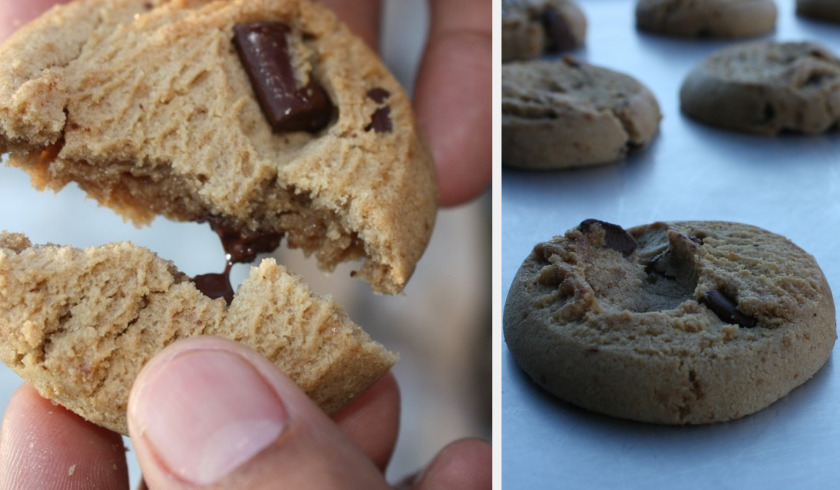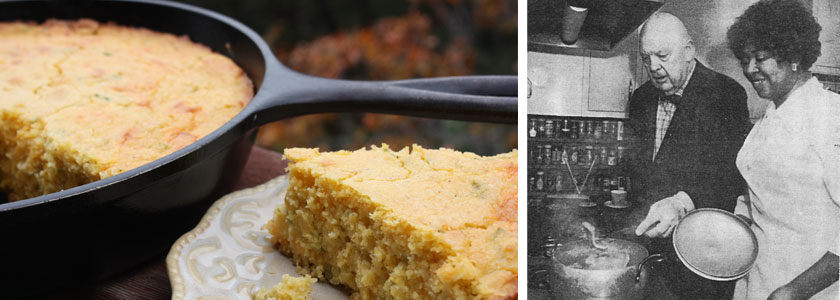
by Toni Tipton-Martin | Feb 17, 2010 | Plantation Cooks
A month into my study of black women cooking in America’s kitchens and already I can see numerous professional characteristics displayed by slave women. Plantation cooks worked under pressure and still devoted attention to detail. Fashioned a creative style under stone-age conditions from meager ingredients. Possessed exceptional organizational skills.
But, it was their forebearing management style that caught my attention this week, following popular British chef Jaime Oliver’s TED challenge that Americans take back responsibility for educating their children about food. If Oliver’s plans to join the Obamas and others in the fight against obesity and food ignorance seems intrusive, it shouldn’t; we live in an era when many adults become completely depressed by the thought of kids in the kitchen.
Not these women. They supervised a gaggle of helpers, some of them young children, without surrendering their hearts to despair just because of the distraction and hazard of children underfoot.
We all know that slavery’s children were exposed to heavy labor at an early age. From Works Progress Administration interviews, we also learn about the skills and traditions their mothers handed down to them as they worked side by side, which reveals a communal spirit, not weakness.
Imagine Mammy or Aunt Chloe redirecting her feelings, telling herself and her children they were allowed “to “play” in her kitchen or to “help out” with the cooking. At the same time, in an informal way, she taught them basic responsibilities, transferred culinary expertise, and instilled confidence and self-esteem, when she allowed the child to accomplish simple tasks like helping her to put on a pot of rice.
Aunt Mary Graham remembered that Mammy Rose, the cook managed the fireplace and several servants at once, including children on her Washington, Louisiana plantation. Aunt Mary was the “table gal,” who learned from the Missus how to “make it fitten fo’ fine folks ter eat at.”
A small girl, usually the cook’s daughter, carried the food to a small table near the kitchen door, then the table gal would carry the meal into the dining room. Mammy Rose, she said, “Didn ‘low no boys ter wait on tables caise dy rush roun’ so fas’ an’ spill things.”
Mandy Morrow, a former Texas slave who cooked in the Governor’s Mansion, was one also of those early trainees. She recalled carrying food pails to the field, managing the smoke in the smokehouse, making preserves, and “making sorghum molasses every year to sweeten the coffee.”
Aunt Charity Anderson, one of six house servants, explains: “My job was lookin’atter de corner table whar nothin’but de desserts set.”
I have to admit that some nights, these narratives troubled my sleep, but most times, I tried to put on my own mother apron and think about the joy I share with my children at the table. And that brought memories of my son Brandon’s Chocolate Chip Cookies to mind. His recipe is a family favorite that grew out of a challenge when he was in middle school and I was a newspaper food editor. He taunted me into a weekend cookie bake-off, which he proceeded to win with this simple, sweet recipe. I make them with the kids in my cooking classes and we still laugh about it today.
What recipe did your mother use to bring you into the kitchen?
In Her Kitchen
Chocolate Chip Cookies
Ingredients
- ½ cup margarine
- ½ cup shortening
- ¾ cup brown sugar, firmly packed
- ½ cup sugar
- 1 ½ teaspoons vanilla
- 1 egg
- 1 ¾ cup all-purpose flour
- 1 teaspoon baking soda
- ½ teaspoon salt
- 1 cup semi-sweet chocolate chips
Instructions
- Preheat oven to 350 degrees. In a large bowl, stir together margarine and shortening until mixed and light yellow. Add sugars and stir until creamy. Stir in vanilla and egg. Stir in flour, soda and salt. Blend well. Stir in chocolate chips and mix well. Wrap in plastic and shape into a 12-inch log. Refrigerate until firm. Slice cookies about ¼-inch thick or drop dough by rounded teaspoonfuls, 2 inches apart onto a lightly greased cookie sheet (or spray with non-stick vegetable spray). Bake for 8 to 10 minutes or until light golden brown. Immediately remove cookies from cookie sheet to wire racks and cool.
Number of servings: 48
In Her Kitchen

by Toni Tipton-Martin | Nov 26, 2009 | Kitchen Tales
By the time I was 30 years old, I could count my Southern life experiences on one hand. When you grow up in a tiny family in Los Angeles, sheltered by expatriates who left skid-marks when they quit the South, it is easy to believe that your family drama does not play east of the San Bernardino Valley. As children of the civil rights era, we lived in exile – sheltered from the narrow perspective of Negro subservience and proper place, liberated from the burden of low-class living. My parents built new and improved lives in the sands of the Pacific.
Not that the social, cultural, or culinary dimensions of Southern living were unrecognizable out West. Sweet tea and fresh-squeezed lemonade washed down Aunt Jewel’s crisp fried chicken, smoked pork bones seasoned Nannie’s Sunday greens, and Mother always baked her cornbread in a big, black cast iron skillet. But that was just dinner; everybody we knew in the middle class community of Baldwin Hills ate that.
I didn’t care all that much for pork ribs and became easily nauseated by the potent smell of chitlins that blasted through the air like a dragon’s fiery breath every time our neighbors from Tennessee opened their front door. Perhaps the most arresting evidence of my Western upbringing was my unapologetic admission that I sprinkled sugar on my grits.
As far as I could tell, precious few of my culinary notions qualified as Southern banners, and it was entirely possible that I would stumble blindly through the rest of my life without ever discovering the Aunt Jemima spirit living in me, if it hadn’t been for Vera Beck.
Vera resembled one of those African American matriarchs who once upon a time were thought of as saints – a woman in her twilight years whose culinary expressiveness was like a gift she bestowed upon the people she loved.
Whenever I think of her – and it’s often – I see a proud, generous, loving, tenderhearted, talented, exceptional cook. She made the best cornbread, chow chow, fried green tomatoes, and Mississippi mud cake I ever ate. And, although she earned her living as my test kitchen cook at one of the few major daily newspapers that dared to preserve the tradition, she was self taught and followed recipes handed down by word of mouth through generations of rural Alabama cooks.
Hers was a tradition that was less instinct and more five senses, but skill nonetheless; one that earned respect from the likes of well-known American cooking authority James Beard, and one that has all but disappeared among contemporary cooks.
As I got to know Vera better, she forced me to circle back and confront the peculiarity Virginia Woolf described as contrary instincts. I thought I was contented – a thirty-something food editor living far away from home on the eastern shore of Lake Erie, enjoying amazing and exotic world cuisine – the daughter of a health-conscious, fitness-crazed cook whose experiments with tofu, juicing and smoothies predated the fads.
In the few short years we had together at the Cleveland Plain Dealer, Vera taught me a few life lessons while showing me the way to light and flaky buttermilk biscuits.
She confirmed what I already had begun to fret about: that growing up as I did – outside the counsel of competent cooks who dispensed first-hand kitchen wisdom the way they apportioned hunks of ham to their children from bubbling pots of collard greens – made me an unfortunate casualty of the cruel social conditioning I call the Jemima Code.
While it is correct that black women did much of the cooking in early American kitchens, it is also true that they did so with the grace and skill of today’s trained professionals, transmitting their astonishing craft orally, from generation to generation.
When we consider the work accomplished by Vera Beck and generations of obscure cooks just like her, we should see a nearly extinct breed that honed their kitchen skills the way culinary students do today: by observation and apprenticeship. They expressed both art and skill when they cooked. They made do, certainly, but they also seasoned our lives and made our existence pleasurable – even under the most adverse circumstances. They cooked our meals from scratch, sewed our clothes, salved our wounds, nurtured our spirits, and imparted wisdom over a steaming plate of nourishment – and they did so while miraculously maintaining jobs outside their homes.
So, how is it that these are not the predominant images of African American cooks? Why don’t we celebrate their contributions to American culture the way we venerate the imaginary Betty Crocker? Why wasn’t their true legacy preserved? Can we ever forget the images of ignorant, submissive, selfless, sassy, asexual, despots? Is it possible to replace the mostly unflattering pictures of generous waistlines bent over cast iron skillets burned into our eyes? Will we ever believe that strong African women, who toted wood and built fires before even thinking about beating biscuit dough or mixing cakes, left us more than just their formulas for good pancakes?
I hope so.
In Her Kitchen
Cornbread with Cheese and Chiles
Ingredients
- 2 cups yellow cornmeal
- 1 tablespoon sugar
- 1 teaspoon baking powder
- 1/2 teaspoon baking soda
- 1/2 teaspoon salt
- 1/2 cup shortening
- 3/4 cup buttermilk
- 1 egg, beaten
- 1 (14.75-ounce) can cream-style corn
- 1 (4-ounce) can diced green chiles, drained
- 1/4 cup chopped green onion
- 1 cup shredded Cheddar cheese
Instructions
In a large mixing bowl, combine cornmeal, sugar, baking powder, soda and salt. Mix well. Melt the shortening in an 8-inch cast iron skillet. Pour shortening, buttermilk and egg into the dry ingredients and mix with a wooden spoon until just moist. Stir in the corn, chiles and green onion and pour half the batter into the hot skillet. Sprinkle with cheese. Top with remaining batter. Bake in a preheated 375 degree oven 30 minutes or until done.
Recipe and photograph courtesy of The Plain Dealer, 1978.
In Her Kitchen




Comments